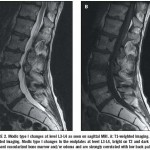Over the next few months many of you will hear about a paper that has just been published in the European Spine Journal. The study, from the University of Southern Denmark, suggest that back pain can be cured with a 100 day course of antibiotics, and certainly they provide some good evidence for that. Certainly some surgeons are calling for a Nobel prize, but I don’t think it’s that significant yet. Maybe if you operate on a lot of people with back pain it’s significant, but those of you who know me, know that surgery for back pain is a last resort.
So, what about the study?
Well, it looked at people who had Modic type 1 changes on their MRI after having a disc herniation, whether or not they had surgery for the herniation. A prior study from the same team, and others, showed that many disc herniations (about half) are infected with a very low grade bacteria called Proprionibacterium acnes which also causes… yep – acne. It has a peculiar ability to be benign enough not to produce an acute inflammatory reaction, but at the same time it produces propionic acid, which is known to be able to dissolve bone. Wow. What a bug.
Now, modic type 1 changes are only about 10-40% of modic changes, the other types being 2, the most common, and 3, the least common. Modic type 1 changes appear dark on the T1 films, and bright on the T2 films, and represent oedema. One way of remembering this is that type 1 changes appear the same as the CSF. See below.

Anyway, back to the study. They randomised the participants into three groups. One group received a placebo, and the other two received the antibiotic (amoxicillin–clavulanate (500 mg/125 mg) tablets three times a day, at 8 h intervals, for 100 days) in two difference doses. They found that the antibiotic subjects improved remarkably well, usually beginning at 6-8 weeks after commencement, after 100 days, and it appears that the improvement lasted out to one year – well after the antibiotics had ceased being taken. Within the placebo group not much changed at all. In addition, the amount of modic change visible on their MRI’s also decreased, which supports the notion that it is due to a chronic low grade infection.
Were there problems with the antibiotics? Mostly gastrointestinal of nature – loose bowel movements and increased flatus. Thanks for asking.
So what does that mean? Well, if I had type 1 modic changes and back pain, I’d be considering this study carefully. However, as a public health measure, we need to realise that this isn’t the cure for ALL back pain – maybe only 10 to 40% of back pain patients. We know that back pain has many causes, but I think it’s just amazing that this subset may have found a cure. Of course, we need to see that these results can be repeated. Hold back on the Nobel prize for now…
John

